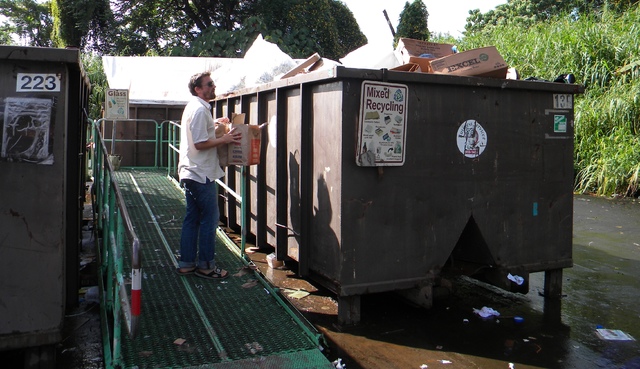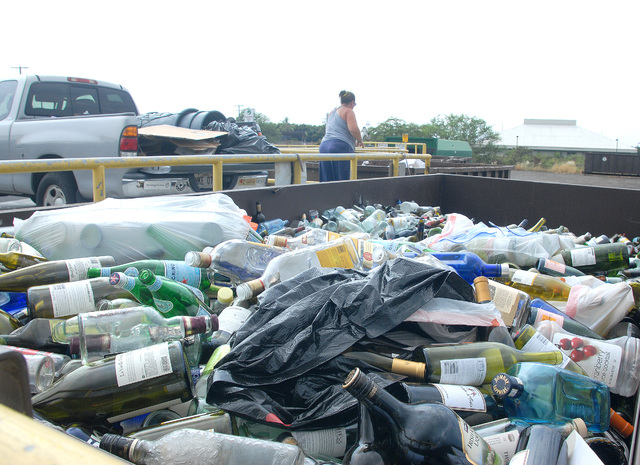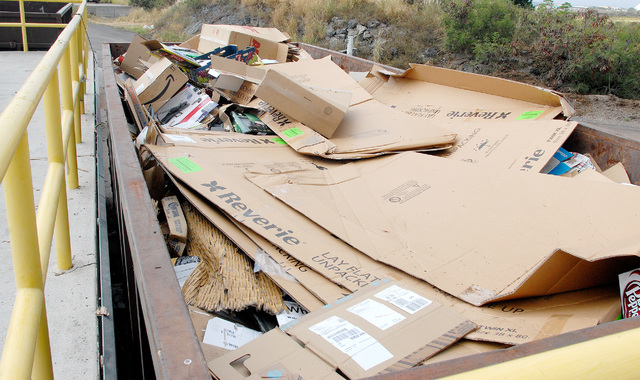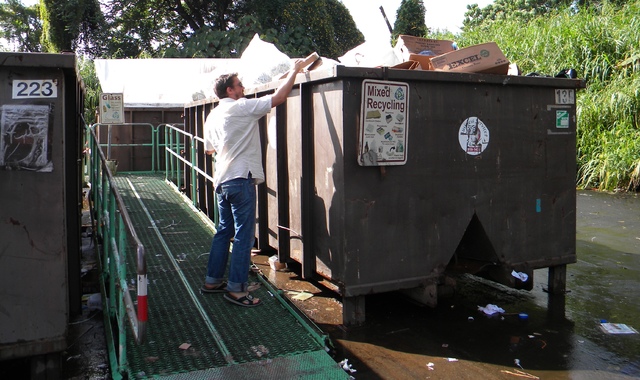Recycling a victim of its own popularity
It was a tight fit, but Julien Petillon found a few spare inches Wednesday morning to squeeze his recycling into the overflowing heap atop the mixed-recycling container at the Hilo landfill.
ADVERTISING
Flies buzzed about but settled quickly back on the bags of paper and plastics in the overfilled container.
“We have very similar in France,” Petillon, who moved to Hilo two months ago, said in accented English.
France’s recycling bins are covered, however, and might not be as full as the ones he was dumping his recycling into in Hilo, he added.
Hilo isn’t the only county recycling facility experiencing overflows as Big Island residents increasingly embrace recycling rather than landfilling their waste.
While the shift to reuse is a positive, it has been leaving one drawback, according to some residents: Overflowing bins where the buildup can be a little, well, gross.
Doug Ward, who regularly takes his waste for recycling to the Kealakehe transfer station, said overflows are worse there.
Ward said the Kealakehe transfer station is a “disgusting mess,” especially on Mondays. He said the bins are so full that people just place their recycling on the apron near the bins, further contributing to the mess.
“The folks are trying to do the right thing,” Ward said. “It’s kind of a slap in the face when they show up and see what a disgusting mess it is.”
Hawaii County tries to keep the bins from overflowing, but there’s a balance between letting them fill to the very top and paying the contract to haul away a half-empty bin, county officials say.
“We want to get a good payload,” recycling coordinator Linda Peters said Friday. “We don’t want them to be hauling empty bins.”
Peters said the county and the contractor monitor the transfer stations and submit reports alerting the drivers it’s time to empty the bins, she said. Drivers also regularly check them.
Recycling is on the rise, climbing about 6 percent this year, while the county’s staffing has remained about the same. There is at least one facility attendant at each of the county’s 22 transfer stations. In addition, there are five full-time staff in the Recycling Division.
Hawaii County residents recycle about 7,000 tons of mixed-materials annually, said Peters.
Geographically smaller Maui has 10 drop boxes for residents to dump non-HI-5 recycling, a county spokesperson said. The county collected about 2,200 to 2,400 tons of mixed recycling last year, a figure that has remained constant.
Oahu residents have actually been recycling their mixed recycling less over the past few years, with tonnage dropping from 490,061 in 2011 to 475,880 last year, according to data compiled by the City and County of Honolulu.
Oahu has 12 drop-off centers for mixed-materials recycling. Currently, 160,000 single-family homes are in the three-cart curbside recycling program serviced with a fully automated collection system. Plans are currently underway to expand curbside recycling to the remaining 20,000 homes that are on manual, refuse-only collection routes, according to the city’s website.
Ward said the problem at Kealakehe seems to be worse on Mondays, and he suggested the county should pay better attention over the weekend.
“More people are recycling than ever before,” Ward said Tuesday. “The county ought to be able to schedule personnel to make sure it doesn’t become a problem.”
Environmental management director Bobby Jean Leithead Todd said Tuesday she’d visited the Kealakehe transfer station that day and everything seemed fine. With 22 transfer stations spread across the island, she can’t personally monitor them all, she said.
She said the Kealakehe site and the Hilo landfill recycling center are the two busiest sites on the island.
Residents can help, Leithead Todd said, by reporting overflowing bins to the contractor, Business Services Hawaii. A spokeswoman there said Wednesday that residents can call 966-7489.
“We’re doing those (in Hilo) daily, sometimes twice a day,” said office manager Jeri Pankey. “At Kealakehe, we’re pretty much doing it every day.”
Residents can also help cut down on the flies and other insects at the sites by not putting food-contaminated containers such as pizza boxes into the recycling, Leithead Todd said. Glass, cans and plastic containers should be rinsed out, she added.
“There shouldn’t be any smell from the refuse,” Leithead Todd said.






